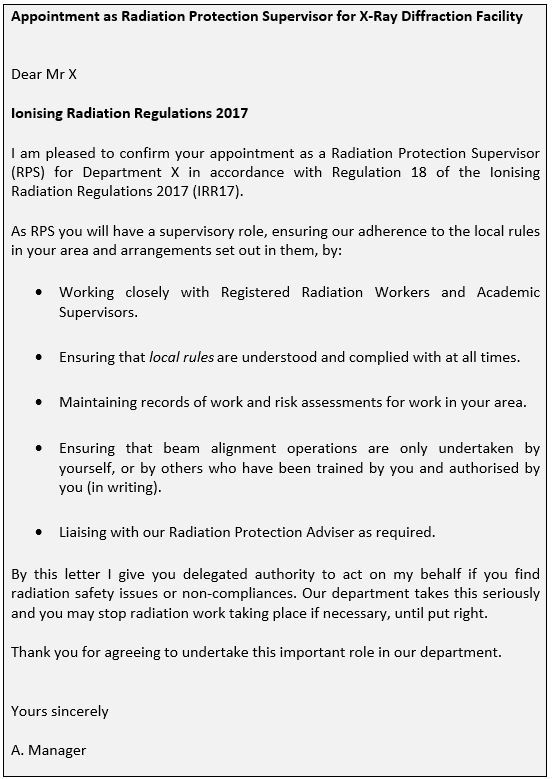IRR17 (18) - Local rules and radiation protection supervisors part 2
Published: Sep 29, 2021
Please also read part 1 of our guidance on IRR17 (18)
Radiation Protection Supervisor (RPS)
The RPS is not responsible for radiation safety. That responsibility cannot be delegated down from senior management – or indeed the ‘employer’.
The RPS role is to assist in meeting compliance, ensuring radiation exposures are as low as reasonably practicable (ALARP), supervising the work in compliance with local rules and offering local advice and support. Note: The RPS is not an "adviser" in the same way as the Radiation Protection Adviser (RPA) - however, the RPS should be competent and confident to provide local advice regarding the content of the the local rules (for example correct use of radiation monitors).
Whoever appoints the RPS needs to ensure the RPS has delegated authority to act (this is not the same as having delegated responsibility). For this reason it is important that the RPS
- should be appointed in writing by a senior responsible manager
- should have an appointment letter which specifies their duties (we advise RPS delegates to not accept an RPS appointment verbally).
The requirement to have an RPS does not replace the employer’s general responsibility under the Management of Health and Safety at Work Regulations 1999 (Regulation 5 and 7 for monitoring and health and safety assistance respectively). This is one reason why the RPS can be appointed regardless of the legal need to do so under IRR17.
Attending a Radiation Protection Supervisor training course does not automatically mean the delegate becomes an RPS - this only happens when formally appointed in writing by their employer.
RPS - are you suitable?
In order for the RPS to be suitable for appointment, they should:
(a) know and understand the requirements of the regulations and local rules relevant to the work with ionising radiation (attend an RPS training course will help)
(b) command sufficient authority from the people undertaking the work (they need to be suitable and in a position to undertake their role with support from management)
(c) understand the necessary precautions to be taken and the extent to which they will restrict exposures (i.e. understand the nature of the sources of ionising radiation in the workplace)
(d) be given sufficient time and resources to carry out their functions (the role will vary between an hour or two a month, and several days a week)
(e) know what to do in an emergency (perhaps the most important requirement, since this is where the RPS will be required to demonstrate their knowledge)
Note (b) - whilst appointing a senior manager or health and safety lead as RPS may have some advantages, it is not always practicable (the RPS needs to be familiar with the work on the 'shop floor'). This is why the wording of the appointment letter needs to make clear that the RPS has delegated authority to act as noted earlier.
Note (e) - an RPS may not always feel their role is given the credit it deserves (often it will be a small part of their day job.) However, when things go wrong their role will quickly raise to the position of 'tell us what we need to do, and we will do it'. So the RPS has to be really clear about their role in implementing contingency arrangements after a radiation accident (e.g. following a radioactive spill of unsealed material in a laboratory).
What does the RPS actually do?
What follows is a list of potential duties and tasks that might be carried out by the Radiation Protection Supervisor. The list is not exhaustive and the reader may think of (or carry out) other duties not listed below.
- Preparation of local rules
- Periodic review of local rules
- Ensure employees are aware of the content of local rules (and comply with them)
- Undertake routine or bespoke radiation and contamination monitoring around the workplace
- Make arrangements for the testing of monitoring instruments
- Perform checks on safety and warning systems (e.g. functional checks of interlocks and emergency stops)
- Issue and collection of personal dosimetry
- Meeting regulators and accompanying them on inspections
- Co-ordination with any relevant contractors on site (who may well be outside workers)
- Regular liaison with the Radiation Protection Adviser
- Make arrangements for annual health reviews (for classified persons)
- Undertake investigations of exposure abnormalities (e.g. unexpected personal dosimetry result)
- Identify training requirements (for RPS, management, employees undertaking radiation work etc)
- Training for new users of ionising radiation.
- Performing risk assessments and determining contingency plans
- Taking part in emergency exercises (contingency plan rehearsal is new in IRR17)
- Radioactive material accountancy and radioactive waste management
- Arranging the disposal of accumulated radioactive waste
- Assist in the design of new facilities
- Undertaking the day to day maintenance of any records in support of the above duties (there are many!)
The employer / RPS should consider obtaining advice from a Radiation Protection Adviser (RPA) ensure the RPS role and local rules are sufficient and proportional to the work being carried out.
How do I appoint the RPS?
An appointment made in writing is required, an example RPS appointment letter is shown below.

